Weinong Wang
LiteLong: Resource-Efficient Long-Context Data Synthesis for LLMs
Sep 19, 2025

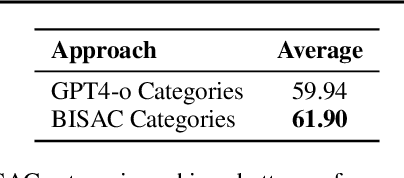

Abstract:High-quality long-context data is essential for training large language models (LLMs) capable of processing extensive documents, yet existing synthesis approaches using relevance-based aggregation face challenges of computational efficiency. We present LiteLong, a resource-efficient method for synthesizing long-context data through structured topic organization and multi-agent debate. Our approach leverages the BISAC book classification system to provide a comprehensive hierarchical topic organization, and then employs a debate mechanism with multiple LLMs to generate diverse, high-quality topics within this structure. For each topic, we use lightweight BM25 retrieval to obtain relevant documents and concatenate them into 128K-token training samples. Experiments on HELMET and Ruler benchmarks demonstrate that LiteLong achieves competitive long-context performance and can seamlessly integrate with other long-dependency enhancement methods. LiteLong makes high-quality long-context data synthesis more accessible by reducing both computational and data engineering costs, facilitating further research in long-context language training.
Omni-DPO: A Dual-Perspective Paradigm for Dynamic Preference Learning of LLMs
Jun 11, 2025Abstract:Direct Preference Optimization (DPO) has become a cornerstone of reinforcement learning from human feedback (RLHF) due to its simplicity and efficiency. However, existing DPO-based approaches typically treat all preference pairs uniformly, ignoring critical variations in their inherent quality and learning utility, leading to suboptimal data utilization and performance. To address this challenge, we propose Omni-DPO, a dual-perspective optimization framework that jointly accounts for (1) the inherent quality of each preference pair and (2) the model's evolving performance on those pairs. By adaptively weighting samples according to both data quality and the model's learning dynamics during training, Omni-DPO enables more effective training data utilization and achieves better performance. Experimental results on various models and benchmarks demonstrate the superiority and generalization capabilities of Omni-DPO. On textual understanding tasks, Gemma-2-9b-it finetuned with Omni-DPO beats the leading LLM, Claude 3 Opus, by a significant margin of 6.7 points on the Arena-Hard benchmark. On mathematical reasoning tasks, Omni-DPO consistently outperforms the baseline methods across all benchmarks, providing strong empirical evidence for the effectiveness and robustness of our approach. Code and models will be available at https://github.com/pspdada/Omni-DPO.
Exploring Implicit Visual Misunderstandings in Multimodal Large Language Models through Attention Analysis
May 15, 2025Abstract:Recent advancements have enhanced the capability of Multimodal Large Language Models (MLLMs) to comprehend multi-image information. However, existing benchmarks primarily evaluate answer correctness, overlooking whether models genuinely comprehend the visual input. To address this, we define implicit visual misunderstanding (IVM), where MLLMs provide correct answers without fully comprehending the visual input. Through our analysis, we decouple the visual and textual modalities within the causal attention module, revealing that attention distribution increasingly converges on the image associated with the correct answer as the network layers deepen. This insight leads to the introduction of a scale-agnostic metric, \textit{attention accuracy}, and a novel benchmark for quantifying IVMs. Attention accuracy directly evaluates the model's visual understanding via internal mechanisms, remaining robust to positional biases for more reliable assessments. Furthermore, we extend our approach to finer granularities and demonstrate its effectiveness in unimodal scenarios, underscoring its versatility and generalizability.
Agent RL Scaling Law: Agent RL with Spontaneous Code Execution for Mathematical Problem Solving
May 14, 2025Abstract:Large Language Models (LLMs) often struggle with mathematical reasoning tasks requiring precise, verifiable computation. While Reinforcement Learning (RL) from outcome-based rewards enhances text-based reasoning, understanding how agents autonomously learn to leverage external tools like code execution remains crucial. We investigate RL from outcome-based rewards for Tool-Integrated Reasoning, ZeroTIR, training base LLMs to spontaneously generate and execute Python code for mathematical problems without supervised tool-use examples. Our central contribution is we demonstrate that as RL training progresses, key metrics scale predictably. Specifically, we observe strong positive correlations where increased training steps lead to increases in the spontaneous code execution frequency, the average response length, and, critically, the final task accuracy. This suggests a quantifiable relationship between computational effort invested in training and the emergence of effective, tool-augmented reasoning strategies. We implement a robust framework featuring a decoupled code execution environment and validate our findings across standard RL algorithms and frameworks. Experiments show ZeroTIR significantly surpasses non-tool ZeroRL baselines on challenging math benchmarks. Our findings provide a foundational understanding of how autonomous tool use is acquired and scales within Agent RL, offering a reproducible benchmark for future studies. Code is released at \href{https://github.com/yyht/openrlhf_async_pipline}{https://github.com/yyht/openrlhf\_async\_pipline}.
SedarEval: Automated Evaluation using Self-Adaptive Rubrics
Jan 26, 2025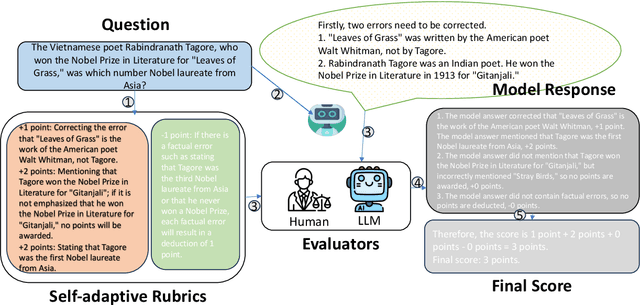

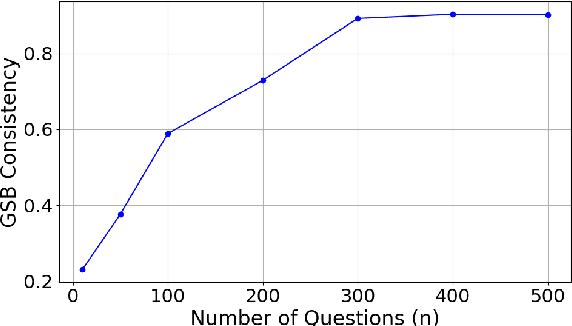
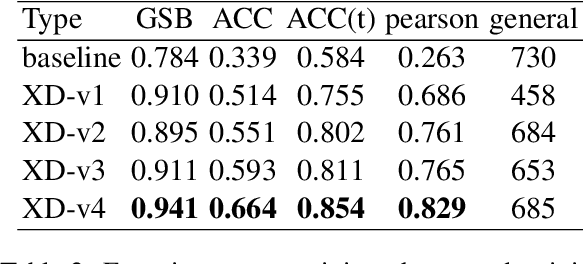
Abstract:The evaluation paradigm of LLM-as-judge gains popularity due to its significant reduction in human labor and time costs. This approach utilizes one or more large language models (LLMs) to assess the quality of outputs from other LLMs. However, existing methods rely on generic scoring rubrics that fail to consider the specificities of each question and its problem-solving process, compromising precision and stability in assessments. Inspired by human examination scoring processes, we propose a new evaluation paradigm based on self-adaptive rubrics. Specifically, we create detailed scoring rubrics for each question, capturing the primary and secondary criteria in a structured format of scoring and deduction points that mimic a human evaluator's analytical process. Building on this paradigm, we further develop a novel benchmark called SedarEval, which covers a range of domains including long-tail knowledge, mathematics, coding, and logical reasoning. SedarEval consists of 1,000 meticulously crafted questions, each with its own self-adaptive rubric. To further streamline the evaluation, we train a specialized evaluator language model (evaluator LM) to supplant human graders. Using the same training data, our evaluator LM achieves a higher concordance rate with human grading results than other paradigms, including GPT-4, highlighting the superiority and efficiency of our approach. We release our dataset at https://github.com/wwn1233/sedareval.
RedStar: Does Scaling Long-CoT Data Unlock Better Slow-Reasoning Systems?
Jan 20, 2025Abstract:Can scaling transform reasoning? In this work, we explore the untapped potential of scaling Long Chain-of-Thought (Long-CoT) data to 1000k samples, pioneering the development of a slow-thinking model, RedStar. Through extensive experiments with various LLMs and different sizes, we uncover the ingredients for specialization and scale for Long-CoT training. Surprisingly, even smaller models show significant performance gains with limited data, revealing the sample efficiency of Long-CoT and the critical role of sample difficulty in the learning process. Our findings demonstrate that Long-CoT reasoning can be effectively triggered with just a few thousand examples, while larger models achieve unparalleled improvements. We also introduce reinforcement learning (RL)-scale training as a promising direction for advancing slow-thinking systems. RedStar shines across domains: on the MATH-Hard benchmark, RedStar-code-math boosts performance from 66.2\% to 81.6\%, and on the USA Math Olympiad (AIME), it solves 46.7\% of problems using only 21k mixed-code-math datasets. In multimodal tasks like GeoQA and MathVista-GEO, RedStar-Geo achieves competitive results with minimal Long-CoT data, outperforming other slow-thinking systems like QvQ-Preview. Compared to QwQ, RedStar strikes the perfect balance between reasoning and generalizability. Our work highlights that, with careful tuning, scaling Long-CoT can unlock extraordinary reasoning capabilities-even with limited dataset and set a new standard for slow-thinking models across diverse challenges. Our data and models are released at https://huggingface.co/RedStar-Reasoning.
Feature Decoupling-Recycling Network for Fast Interactive Segmentation
Aug 08, 2023Abstract:Recent interactive segmentation methods iteratively take source image, user guidance and previously predicted mask as the input without considering the invariant nature of the source image. As a result, extracting features from the source image is repeated in each interaction, resulting in substantial computational redundancy. In this work, we propose the Feature Decoupling-Recycling Network (FDRN), which decouples the modeling components based on their intrinsic discrepancies and then recycles components for each user interaction. Thus, the efficiency of the whole interactive process can be significantly improved. To be specific, we apply the Decoupling-Recycling strategy from three perspectives to address three types of discrepancies, respectively. First, our model decouples the learning of source image semantics from the encoding of user guidance to process two types of input domains separately. Second, FDRN decouples high-level and low-level features from stratified semantic representations to enhance feature learning. Third, during the encoding of user guidance, current user guidance is decoupled from historical guidance to highlight the effect of current user guidance. We conduct extensive experiments on 6 datasets from different domains and modalities, which demonstrate the following merits of our model: 1) superior efficiency than other methods, particularly advantageous in challenging scenarios requiring long-term interactions (up to 4.25x faster), while achieving favorable segmentation performance; 2) strong applicability to various methods serving as a universal enhancement technique; 3) well cross-task generalizability, e.g., to medical image segmentation, and robustness against misleading user guidance.
Few-Shot Model Adaptation for Customized Facial Landmark Detection, Segmentation, Stylization and Shadow Removal
Apr 19, 2021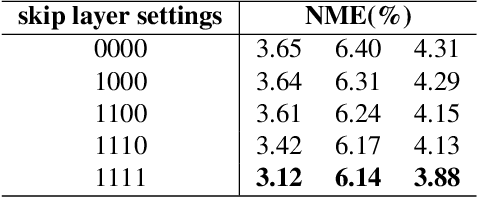

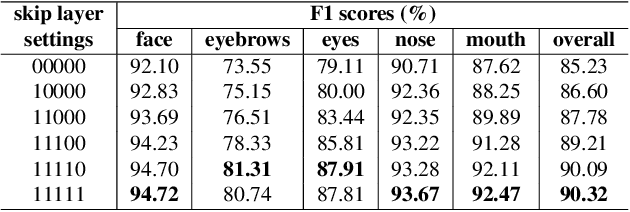
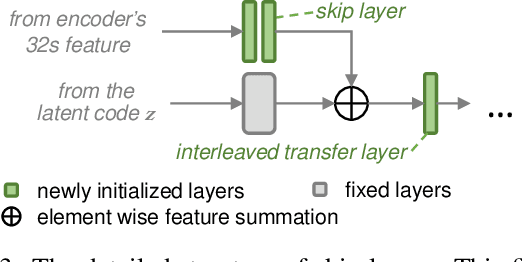
Abstract:Despite excellent progress has been made, the performance of deep learning based algorithms still heavily rely on specific datasets, which are difficult to extend due to labor-intensive labeling. Moreover, because of the advancement of new applications, initial definition of data annotations might not always meet the requirements of new functionalities. Thus, there is always a great demand in customized data annotations. To address the above issues, we propose the Few-Shot Model Adaptation (FSMA) framework and demonstrate its potential on several important tasks on Faces. The FSMA first acquires robust facial image embeddings by training an adversarial auto-encoder using large-scale unlabeled data. Then the model is equipped with feature adaptation and fusion layers, and adapts to the target task efficiently using a minimal amount of annotated images. The FSMA framework is prominent in its versatility across a wide range of facial image applications. The FSMA achieves state-of-the-art few-shot landmark detection performance and it offers satisfying solutions for few-shot face segmentation, stylization and facial shadow removal tasks for the first time.
Orthogonal Center Learning with Subspace Masking for Person Re-Identification
Aug 28, 2019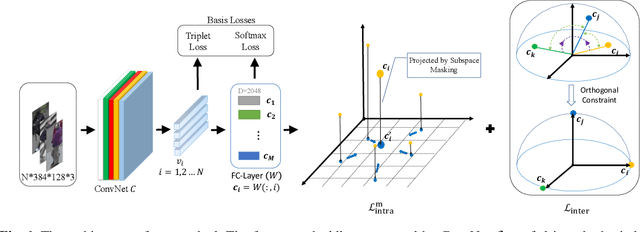



Abstract:Person re-identification aims to identify whether pairs of images belong to the same person or not. This problem is challenging due to large differences in camera views, lighting and background. One of the mainstream in learning CNN features is to design loss functions which reinforce both the class separation and intra-class compactness. In this paper, we propose a novel Orthogonal Center Learning method with Subspace Masking for person re-identification. We make the following contributions: (i) we develop a center learning module to learn the class centers by simultaneously reducing the intra-class differences and inter-class correlations by orthogonalization; (ii) we introduce a subspace masking mechanism to enhance the generalization of the learned class centers; and (iii) we devise to integrate the average pooling and max pooling in a regularizing manner that fully exploits their powers. Extensive experiments show that our proposed method consistently outperforms the state-of-the-art methods on the large-scale ReID datasets including Market-1501, DukeMTMC-ReID, CUHK03 and MSMT17.
 Add to Chrome
Add to Chrome Add to Firefox
Add to Firefox Add to Edge
Add to Edge